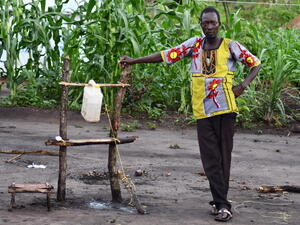World Water Day: How UNHCR is making water safe and plentiful in eastern Sudan
World Water Day: How UNHCR is making water safe and plentiful in eastern Sudan

Refugees gather at a water storage tank at the Abuda camp in eastern Sudan.
KHARTOUM, Sudan, March 20 (UNHCR) - The UN refugee agency has made a major effort over the past year to improve water storage and distribution systems in eastern Sudan refugee camps and to educate people about how to keep the precious resource potable.
Josephine Nakijoba, a UNHCR community services officer in the eastern Sudan town of Kassala, noted that you can tell a great deal about the quality of water from the way people store it. She said that if you were a guest in someone's shelter and "the host pours the water from a jerry can, one can assume the receptacle is clean and the water has been stored safely."
But she added that "if a cup is dipped into an open pot to draw water, chances are the water has been exposed to dust and other forms of contamination." Jerry cans are a standard part of UNHCR assistance packages for refugees, so the agency encourages people to use them for storage.
And in the semi-arid and dusty conditions of eastern Sudan, water is a life-sustaining and limited resource. UNHCR and its partners assist some 56,000 refugees in 12 camps, while an estimated 40,000 eke out a living in rural and urban concentrations.
Dubbed "the forgotten people" by High Commissioner for Refugees António Guterres during a 2007 visit, the exiles from Eritrea, Ethiopia and Somalia have long lived and shared resources - including water - with the very poor but generous eastern Sudanese.
Rivers and canals are the main sources of water in six of the camps, while the refugees rely on deep boreholes in the remaining camps. Under normal conditions, the daily volume of water pumped for distribution ranges from 10 litres per person per day in some camps to more than 30 litres in others - the normal minimum is regarded as 15-20 litres per person a day.
Last year, the UNHCR teams based in the eastern town of Kassala In 2008, conducted a major upgrade of the water distribution systems in the camps with special funds set aside by the High Commissioner.
"We brought in new generators, water engines and pumps, and constructed elevated tanks and ferrocement tanks to replace outdated components that were installed up to three decades ago," explained Water and Sanitation Engineer Nirmal Tandukar. "Major works were carried out on pipelines, distribution points, boreholes and elevated tanks to be used as balancing reservoirs."
Tandukar said ferrocement - a simple, light and cheap composite material of cement, sand, water and wire mesh - was used to construct six tanks in Shagarab camp and one in Wadsherife camp. These enhancements to the water systems have had a significant and positive impact on the lives of the refugees, but UNHCR does not plan to stop there.
"Responding to refugee needs for water is not a one-dimensional affair. A concerted effort is needed," stressed Mohamed Dualeh, head of the UNHCR sub-office in Kassala, adding that this would entail working with refugees to promote proper hygiene practices and continuously monitoring the impact of the agency's interventions.
"If we fail to do so, refugees may resort to drawing untreated water from open sources for domestic consumption," he said, adding that UNHCR has already started focusing on storage and hygiene issues.
For starters, a local implementing partner conducts sensitization activities about safe water use and also helps the refugees to run water management committees. "Refugees have established timetables for drawing water at distribution points. There is now less crowding and we no longer have incidents of aggression by frustrated refugees," said Savalla Shibembe, a UNHCR field officer based in Kassala.
And UNHCR visitors have started advising refugees how to store and use drinking water in the home. "Having made adequate potable water available for refugees, we now focus our attention on how it is utilized in the home. Community sensitization campaigns educate refugees about the risks of water contamination and disease," said UNHCR's Nakijoba.
"The home visitors who call on refugee families are trained to observe hygiene practice and broach the subject of water safety in a friendly reassuring manner so as not to appear intrusive," she added. It's probably safe to assume that at more and more of the homes she visits in eastern Sudan, Nakijoba will be offered water from a jerry can.
By Safa Osman in Khartoum, Sudan









